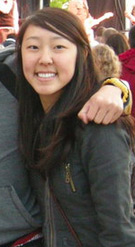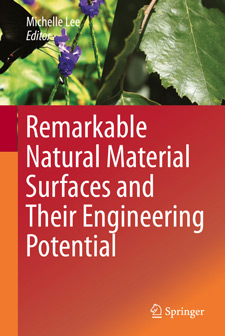New Student-Authored Book Uncovers the Practical Application of Nature
13-chapter book published this month looks at engineering applications of shark skin, butterfly wings
In fall 2012, undergraduate students in the McCormick School’s “Introduction to Tribology” course received a challenging assignment: Select a surface in nature and write a paper about its properties’ engineering applications.
Frog skin, butterfly wings, lotus leaves and pine needles all made the cut. Professor Qian Jane Wang, the course’s instructor and professor of mechanical engineering, was so impressed by the papers that she told her students, “We should try to get these published as a popular-science book.”
 Michelle Lee (mechanical engineering ’13) took those words to heart — and, for the next eight months, focused on compiling, writing and editing more than a dozen papers for publication. Her hard work paid off: This month, the 13-chapter book, Remarkable Natural Material Surfaces and Their Engineering Potential, was published by Springer Science+Business Media.
Michelle Lee (mechanical engineering ’13) took those words to heart — and, for the next eight months, focused on compiling, writing and editing more than a dozen papers for publication. Her hard work paid off: This month, the 13-chapter book, Remarkable Natural Material Surfaces and Their Engineering Potential, was published by Springer Science+Business Media.
While Lee took the lead on the project, four other students from her class — Mindie Chu ’13, Shiqi Luohong ’12, Ignacio Estrada ’14, and Yunho Yang ’13 — also submitted chapters.
Estrada’s chapter, “Botanical Leaves: Groovy Terrain,” explored the hydrophobic properties of rice leaves — that is, the leaves’ ability to repel rainwater and debris as a result of its surface’s angles.
“It turns out that this is very useful for a lot of applications,” said Estrada, explaining that scientists have replicated these angles to create materials that repel water on antennas, concrete, and more. “For example, it’s really expensive to clean the windows of skyscrapers. But if you coat them with this material, it keeps rain and dirt off of them.”
Similarly, one of Lee’s chapters, “Shark Skin: Taking a Bite out of Bacteria,” investigates the antibacterial properties of shark skin, which can be used in hospital settings to prevent the spread of infection. “Like this, a lot of engineering applications are very practical,” Lee noted.
 Each of the book’s chapters explore the future applications of natural properties in the engineering space. For instance, there’s evidence that hydrophobic materials could be used to coat prescription drugs as a means of slowing down the release of active ingredients. That means that people who take large quantities of drugs — such as cancer patients — could “take a single pill that lasts a week or a month instead of taking three pills a day,” said Estrada. “That is huge.”
Each of the book’s chapters explore the future applications of natural properties in the engineering space. For instance, there’s evidence that hydrophobic materials could be used to coat prescription drugs as a means of slowing down the release of active ingredients. That means that people who take large quantities of drugs — such as cancer patients — could “take a single pill that lasts a week or a month instead of taking three pills a day,” said Estrada. “That is huge.”
For her part, Professor Wang wrote the book’s foreword, collected photos for several chapters, solicited feedback from her colleagues, and shepherded Lee through the book proposal process.
“Our students have great potential … even at the stage of their undergraduate studies,” said Wang. “As a professor, I should help them go as far as they can.”
Lee says that the book was written with a lay audience in mind. She wants more people — not just those with technical expertise or engineering backgrounds — to understand nature’s power and potential to change the way we live.
“There are so many things in nature that can offer so much scientific intelligence and engineering wisdom,” Lee said. “And a lot of people don’t know they exist. I certainly didn’t know about them before Professor Wang had us do this project.”